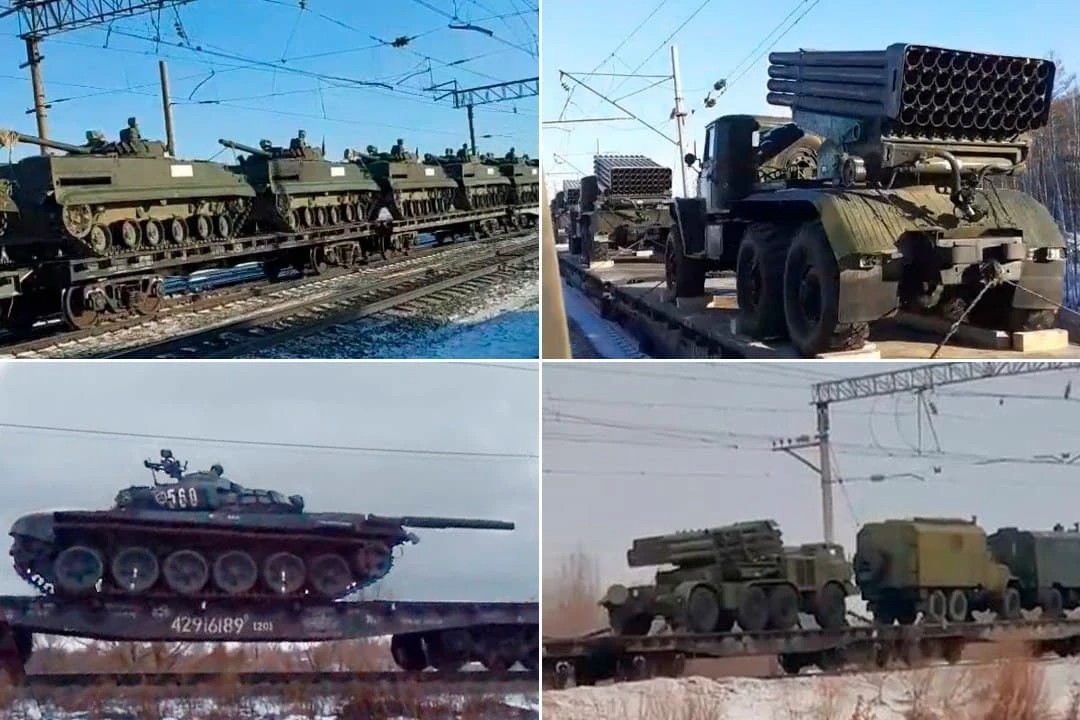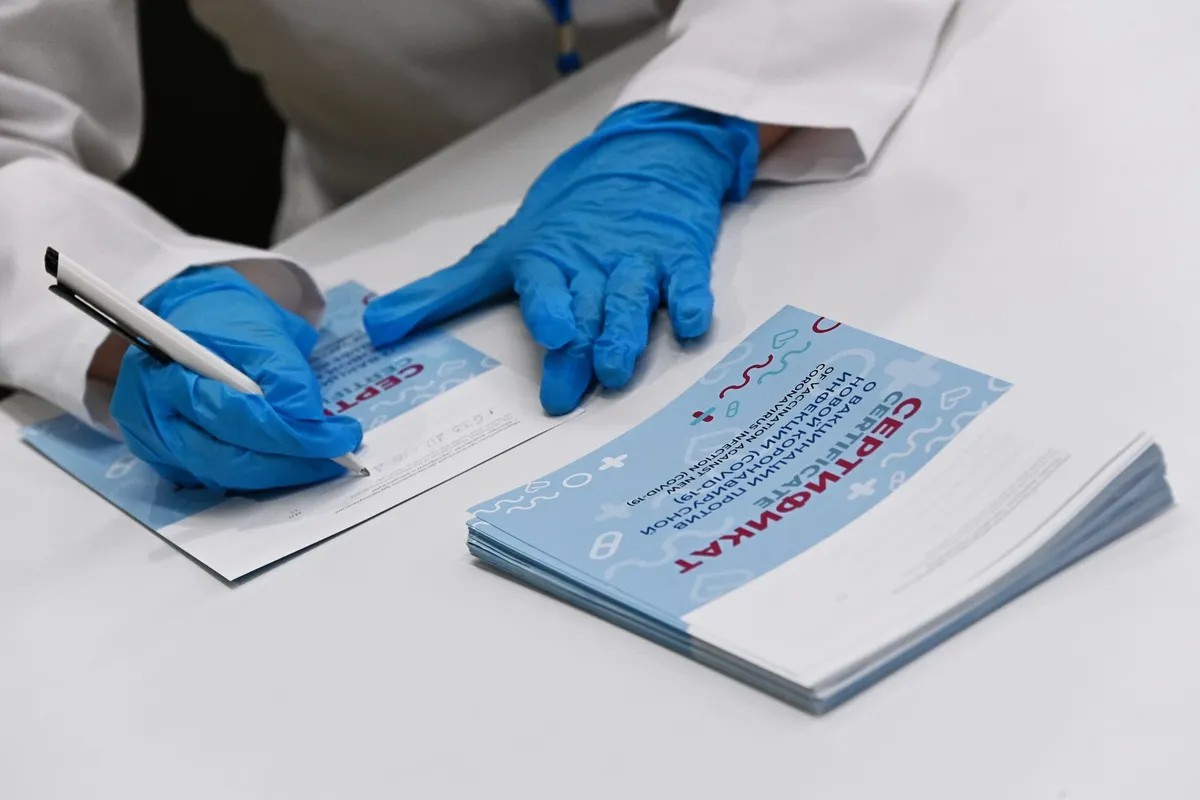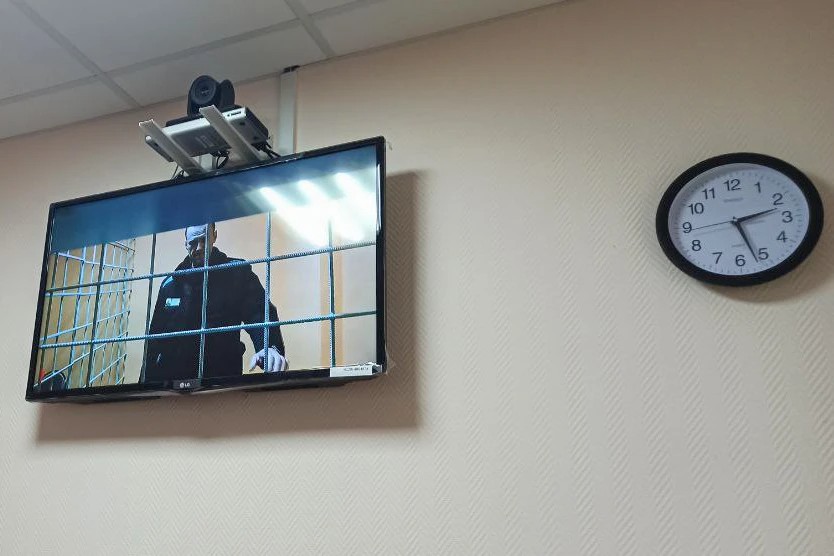
Russian tanks moving to the west border. Photo: social media
Here what’s in store for you this week:
- This week we explain why the Kremlin is sending enormous amounts of weapons to the western borders, but no crews to man them;
- On the one year anniversary of Alexei Navalny’s imprisonment we look into his options for the future;
- We investigate the sale of vaccine certificates and find that up to 10 million Russian citizens are able to buy fakes;
The Potemkin Village of Russian Military Buildup
Global headlines are filled with details of the enormous military buildup of Russian troops at the Ukrainian border. As western talks with the Kremlin fail one after another and Europe is faced with growing security challenges, Moscow makes no attempt to hide the constant stream of military hardware that it is sending from the country’s Far East to western borders. The only peculiar thing about it — the equipment is unmanned. This week our defence columnist Valeriy Shiryayev explains how this is all part of Russia’s negotiation strategy.
‘A GHOST IS HEADING TOWARDS EUROPE. THE GHOST OF MILITARISM. From the Far East, from Buryatia and Eastern Siberia, trains with military equipment are heading to the West. But the crews do not accompany artillery and anti-aircraft systems. There is no one in the echelons, except for logistics teams. These are not the usual fast movements (for example, to annex Crimea or invade Kazakhstan). Two days ago, some of these shipments passed Novosibirsk, and they are not very well visible for NATO satellites, yet. Will they all reach Europe, or will they only partly mark a formidable movement? Very likely, it depends on the progress of the negotiations,’ Shiryayev writes. He points out how the Kremlin skillfully uses disinformation and fear-mongering to turn a relocation of military gear into a negotiation weapon on its own.
RUSSIA IS PILING ON THE PRESSURE…. “This is not an invasion force in the Donbass”, Shiryayev asserts, “This is how our military supports the efforts of diplomats preparing to continue negotiations with the US and NATO.” In other words, the Kremlin is not hiding the tanks and anti-aircraft systems rolling towards Ukraine because the whole point is visibility. As if to highlight the performative nature of these deployments, the hardware is arriving conspicuously without personnel, save for those managing the transportation.
WHILE SEEMINGLY THE MAIN CHARACTER, THE MILITARY IS ACTUALLY ONLY PLAYING A SUPPORTING ROLE IN THE “EPIC PROPAGANDA BATTLE” that began last November. Bloggers are also playing an important role, with nationalists frequently sharing videos of military equipment heading from Siberia to Ukraine. ‘They are coming! Wait! Be afraid! The number of Russian troops at NATO and Ukrainian borders will soon increase to 500, 000,’ these posts warn. It doesn’t matter that in 2021, the number of our ground forces was about 280,000. The Ministry of Defence neither confirms nor denies their veracity: “the more videos the better. This is also part of the negotiation process.”
…AND SO IS THE WEST. The U.S, Ukraine, and NATO are not above participating in this dangerous war of perceptions, argues Shiryayev. In November last year, Ukrainian Armed Forces Chief Kirill Budanov gave to American journalists a map allegedly illustrating Russia’s invasion plan. Speaking with military sources, Shiryayev points out that the plan “does not withstand any criticism” and was merely a prop to raise the temperature. The supposed ‘leak’ from the State Department which appeared to show that U.S. citizens were being evacuated from Ukraine in expectation of an invasion (they were actually only leaving for the winter holidays) served a similar purpose.
A DANGEROUS GAME. Amid all this media hysteria and military performance, intensive diplomatic talks continue. Both sides declare their desire to de-escalate tensions. However, the ‘game’, writes Shiryayev, may soon escape the control of its players. The greater the hysteria and the hotter the words, the more likely real combat will occur. And it is Ukrainian civilians who will pay the price.
BACKSTORY. The so-called «Donetsk People's Republic» and «Luhansk People's Republic» remain home to 3,000,000 residents despite heavy fighting sporadically breaking out in the area. The breakaway territories became self-proclaimed statelets after the 2014 pro-democratic revolution in Ukraine. The separatist movement was part of the Kremlin attempt to preserve political and economic control over the country. As then-president Ukrainian president Yanukovych fled to Russia, Moscow annexed the Ukrainian region of Crimea while stoking unrest in the country's eastern regions — effectively establishing control over 7 percent of the Ukrainian territory. At the time, Russian state propaganda manufactured a false narrative of an ethnic divide in Ukraine. It has been using it as an excuse to keep meddling in Ukrainian affairs since then. Moscow has never officially acknowledged the invasion of Eastern Ukraine. Still, the presence of Russian troops on the ground is well-documented, including by Novaya. The seven-year war has left approximately 13,500 dead, 1.6 million internally displaced, and over 800,000 refugees.
Read Shiryayev’s explainer in full here.
Fake Russian Vaccine Certificates for Sale
As the Omicron variant of Covid-19 sweeps the globe, Russia continues to be one of the hardest hit countries with new cases per day doubling from 15,000 to 30,000 in the first working week of 2022. As federal and local authorities consider more restrictive measures, thousands — if not millions — of Russians are turning to fake vaccination certificates to avoid restrictions. Our data investigative unit studied data from the regions in order to understand how many Russians have actually been vaccinated and why law enforcement agencies are in no hurry to deal with false certificates.

Photo: RIA Novosti
Поддержите
нашу работу!
Нажимая кнопку «Стать соучастником»,
я принимаю условия и подтверждаю свое гражданство РФ
Если у вас есть вопросы, пишите [email protected] или звоните:
+7 (929) 612-03-68
THE STUDY. Establishing how many many fake certificates have been purchased is no easy task. No federal agency publishes data on how many patients with fake certificates have ended up in hospital, nor on how many fraudsters have been detained by police for selling them. One of our methods was collecting data on sites registered in the Russian-speaking segment of the Internet (.ru and .rf) from May 1, 2021 to January 17, 2022 to see the number of websites with the words “vaccine”, “certificate”, “buy a certificate” and other related terms (in the Latin alphabet as well as Cyrillic.) To understand how the situation varies across Russia, we interviewed all the regional departments of the Ministry of Internal Affairs, receiving answers from 70 departments out of 85.
THE RESULTS. Results from our online study peaked first when the Moscow authorities introduced the QR code requirement and next when the State Duma introduced the QR code bill. According to the answers from the Ministry of Internal Affairs departments, 472 criminal cases on “forgery of documents in connection with the coronavirus infection” have been opened. Tambovskaya Oblast and the Yamalo-Nenets Autonomous Okrug launched the greatest number of criminal cases: between 4-6 cases per every 100,000 inhabitants. 9 regions have opened no cases at all.
DATA DISPARITY. The number of criminal cases does not necessarily reflect the number of fake vaccine certificates. Firstly, one case can include multiple fakes. For example, last July in Moscow, police reported that more than 700 fake certificates were seized in the capital and more than 60 criminal cases were initiated. One case, therefore, could contain tens or even hundreds of fake certificates.
SECONDLY, MANY AUTHORITIES ARE RELUCTANT TO OPEN CASES IN THE FIRST PLACE. Russian authorities have been lying about the real number of Covid-19 infections, then about Covid-19 vaccinations, so no official wants another publicity disaster on their hands. At the same time, vaccination resistance and skepticism about the quality of Russian-made vaccines (the only kind allowed) are widespread. Coupled with chronic corruption, it provides fertile ground for the market of fake vaccination documents. In November, for example, the Moscow department of the Ministry of Internal Affairs refused to initiate a case in connection with the sale of fake vaccination documents on Instagram. The department said that the social network is registered outside of Russia, so it is “not possible” to request information about the page’s administrators.
RESEARCHERS DISAGREE. In Autumn 2021, Alexander Gintsburg, director of the Gamaleya Center where the Sputnik V coronavirus vaccine was developed, stated that 80% of those seriously ill with coronavirus had bought a certificate. By this metric, about 22 million recorded vaccinations are fake. Analyst Viktor Kabanov, who investigates vaccination data in Russia disagrees with Gintsburg’s estimate. According to him, the number of fakes is more than half a million, but less than 10 million.
THE KREMLIN IS DISTANCING ITSELF. On January 14, Deputy Prime Minister Tatiana Golikova announced that the second reading of controversial bill on the nationwide introduction of QR codes to prove vaccination status had been postponed. According to Boris Vishnevsky — a member of the party Yaboloko and member of the St. Petersburg legislature — the decision indicates the Kremlin’s desire to distance itself from citizens’ ire. They fear that the mass protests in Kazakhstan could happen in Russia. By avoiding a federal law, Vishnevsky continues, “the regional governors will be responsible for citizen’s discontent, and not Putin at all.”
BACKSTORY. Russia was the first country in the world to roll out a Covid-19 vaccine. But according to official statistics, only 48 percent of the country's population are fully vaccinated — one of the lowest rates on the continent. The majority of Russians are not willing to be immunized against COVID-19 and the overall vaccination campaign is considered a failure. This is a result of traditionally strong anti-vaxx sentiments in the country and widespread doubts about the quality of Russian-produced vaccines. According to our independent AI-powered COVID-19 tracker, over 634,000 Russians might have died from Covid-19. Official statistics say only 324,000 did. Our investigations have exposed the government «doctoring» both mortality and vaccination rates linked to Covid-19. There is also a high death rate among doctors and a general shortage of personnel in hospitals. Russian doctors are sacrificing everything to save people amid government attempts to silence them from speaking out.
Read our report on vaccine certificate sales here and Vishnevsky’s analysis here.
The Year of Navalny in Jail, Examined
On January 27, 2021, politician Alexei Navalny returned to Russia from Berlin, where he underwent rehabilitation after being poisoned in 2020. Police detained him at Sheremetyevo airport. After a sham trial, the court sentenced him to two years in a penal colony in the Vladimir region, changing his suspended sentence in the Yves Rocher case into a real one. Our correspondent Daria Kozlova and our political editor Kirill Martynov explain how the opposition leader has changed the political landscape and shown what ‘freedom’ means in today’s Russia.

Alexei Navalny during the court speaking from jail by videoconference. Photo: RIA Novosti
THE ‘DIMON’ BREAKTHROUGH. In 2017, Navalny and his team published an investigative film on the secret and ill-gotten wealth of former President — and then Prime Minister — Dmitry Medvedev entitled “He is not Dimon to You” (Dimon being the diminutive form of ‘Dmitry’). The YouTube video was watched by 26 million people in 2021 alone and sparked large-scale anti-corruption rallies across the country. Kozlova interviewed researchers Ben Noble (University College London) and Morvan Lalluet (University of Kent), who explained that these protests brought Navalny’s movement unprecedented visibility and buy-in from previously unengaged citizens that would prove invaluable for the 2018 presidential campaign.
TURNING POINT. The 2018 Russian presidential elections and their runup transformed Navalny’s movement from a small, if vocal, opposition group to a political organisation of national scale and stature. A major step in this process was the creation of 81 regional campaign headquarters from Kaliningrad in the west to Komsomolsk-na-Amur in the east. Noble and Lalluet who note that the nationwide network has helped build links between regional activists: in many cities, its branches have become new centres of political and other activity that go beyond the presidential campaign.
REPRISALS. In retaliation for the challenge they had posed to Kremlin control, the Russian authorities launched a fierce clampdown against Navalny supporters at all levels. In June, the Moscow City Court recognized Navalny's Anti-Corruption Foundation and network of headquarters as “extremist organisations”, banning their activities in Russia. The first person arrested in the «extremist case» was the former head of Navalny's headquarters in Ufa, Lilia Chanysheva. She faces up to 10 years in prison. Her fate prompted more than half of the former HQ coordinators to flee the country.
VICTIMS OF THEIR OWN SUCCESS. The efficiency of the regional headquarters was the reason that the Kremlin could not tolerate their continued existence. Carnegie’s Andrei Kolesnikov emphasised this point, stating that “Being deprived of the opportunity to enter politics through the front door, Navalny came up with a tool for truly grassroots political participation […] it was the efficiency of their work that caused them to be burned with napalm.” Navalny’s most recent arrest and subsequent imprisonment is the ultimate indication of how successful his movement had become.
FINDING FREEDOM IN IMPRISONMENT. Navalny may be behind bars, writes Martynov, but he is more free than anyone who has so far avoided arrest. Self-preservation, he argues, means “completely submitting to the authorities”. Navalny’s apparently self-destructive move in returning to Russia is therefore a radical assertion of personal freedom against the psychological and physical oppression instituted by the Kremlin. “It was not Navalny, but Russia, who they locked in a cell”, Martynov writes, highlighting how most Russian citizens gave up their rights without a fight and now see political persecution as normal. “Being alone with free people is already too terrible a test for the Russian authorities”, he bitingly concludes, “it is easier to fence them off with barbed wire.”
BACKSTORY. Alexei Navalny has been a thorn in the Kremlin’s side for over a decade. His Anti-Corruption Foundation has been responsible for exposing graft inside large swathes of Russia's ruling elite in recent years. As a consequence, the authorities targeted it with repressive 'foreign agent’ laws, eventually dismantling the organisation after accusing it of “extremism”. In August 2020, Navalny suffered a poisoning attempt widely believed to have been orchestrated on the Kremlin’s orders. After being hospitalized in Germany, he returned to Moscow and was immediately detained. Russian authorities accused him of violating the terms of his parole concerning a years-old embezzlement case (2014), thought to be politically motivated, and sentenced to more than two years in a penal colony.
Bonus Round
Novaya reports on Chechen authorities kidnapping a wife of a prominent regime critic. Kadyrov calls us ‘terrorists.’
We’ve been following a shocking attack on a prominent human rights defender Abubakar Yangulbayev and his family over the weekend. Chechen police kidnapped the mother of the regime’s critic in Nizhny Novgorod, almost 2,000 km north of the autonomous region run by a tyrannical Kremlin-backed regime. Yangulbayev’s father, a reserve federal judge Saidi Yangulbayev, had to flee the country earlier.
This is not the first time Chechen officials reach across regional and international borders to target critics. The same tactic is often used to hunt down victims of LGBTQ+ pogroms or dissident critics on the run for their lives. Kadyrov publicly defended the extrajudicial kidnapping, promising to make sure that the Yangulbayevs end up either in jail or dead. He also attacked (once again) our special correspondent Elena Milashina for breaking the story by calling her ‘a terrorist.’ Novaya released a public statement condemning both the kidnapping and hate speech targeting our journalists: ‘We do not consider this a conflict between the editorial board and Kadyrov. This is not our private matter. It is up to the federal authorities, the Kremlin, to react to such blatant behavior that outraged many. After all, Kadyrov is the head of one of the regions of the Russian Federation. And a general in the Ministry of Internal Affairs, by the way.’ Our previous demands for federal authorities to investigate crimes of the Kadyrov regime and his threats against our journalist were left without proper action.
This newsletter drop is written and edited by several journalists at the Novaya Gazeta newsroom. Please, support our work by promoting our newsletter with #RussiaExplained hashtag on social media.
To keep up with Novaya Gazeta’s reporting throughout the week, you can follow us on Facebook, Twitter, Instagram, and Telegram. Our video content is available on Youtube and don’t forget to visit our website for the latest stories in Russian.
The Novaya Gazeta Team